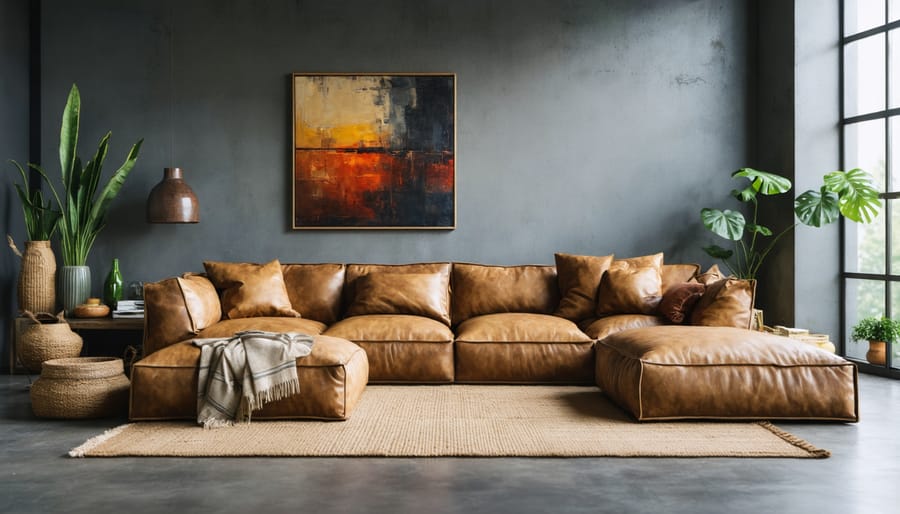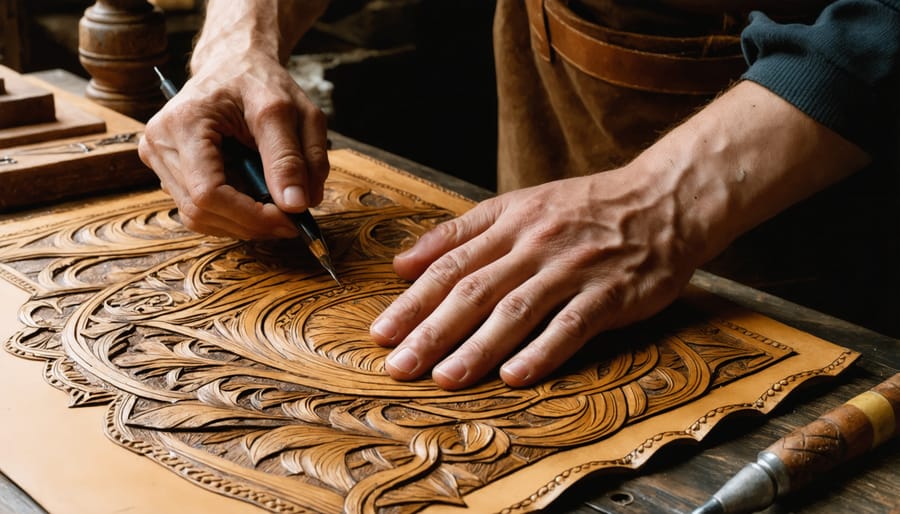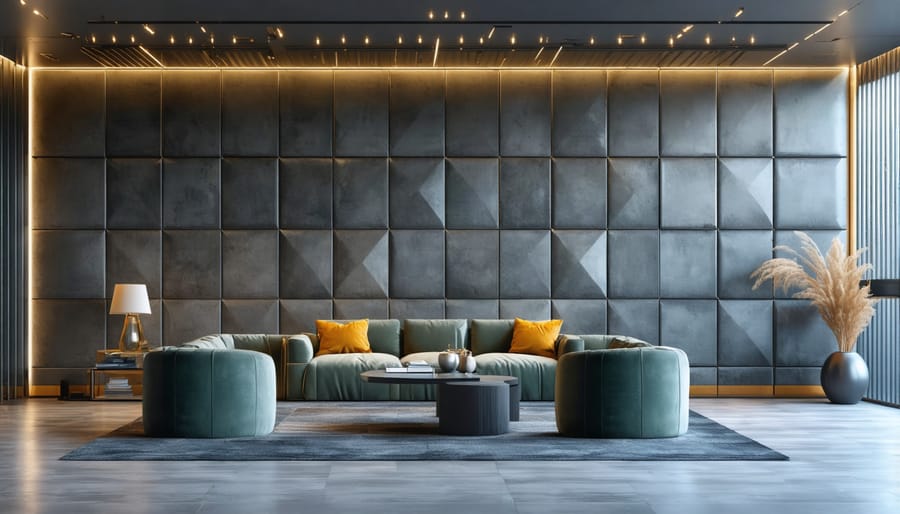Transform your living space with handcrafted leather designs that blend timeless artistry with modern aesthetics. From intricately tooled wall panels to custom furniture accents, leather work represents one of the most versatile and transformative artisan designs in contemporary home decor. Master craftsmen have spent centuries perfecting techniques that bring out leather’s natural beauty – the rich patinas, distinctive grain patterns, and subtle variations that make each piece uniquely striking.
Today’s leather artisans combine traditional methods with innovative approaches, creating pieces that range from minimalist geometric patterns to elaborate botanical motifs. Whether you’re drawn to the raw elegance of vegetable-tanned leather or the sophisticated finish of embossed designs, this ancient material offers endless possibilities for elevating your home’s character. The growing appreciation for sustainable, long-lasting materials has placed leather work at the forefront of conscious design, appealing to both traditionalists and modern design enthusiasts seeking to add warmth and personality to their spaces.
The Enduring Appeal of Leather in Home Decor
Why Leather Never Goes Out of Style
Leather’s enduring charm in interior design isn’t just about durability – it’s about character. Like a fine wine, leather develops a rich patina over time, telling stories through its weathered beauty. This timeless material seamlessly integrates with various modern home design elements, from sleek contemporary spaces to rustic farmhouse aesthetics.
What makes leather truly special is its versatility. Whether it’s a vintage leather armchair anchoring your living room or handcrafted leather wall panels adding texture to your study, leather pieces become statement features that grow more beautiful with age. The material’s natural variations in color and texture create unique patterns that can’t be replicated by synthetic alternatives.
In today’s fast-paced world of trending materials and fleeting styles, leather stands as a testament to sustainable design choices. Its durability means fewer replacements over time, while its neutral tones and natural appeal complement virtually any color scheme or design update. From minimalist Japanese-inspired interiors to bold industrial lofts, leather’s adaptability makes it a designer’s dream material for creating spaces that feel both current and timeless.

Modern Applications of Traditional Techniques
Today’s leather artisans are breathing new life into time-honored techniques, creating pieces that seamlessly blend traditional craftsmanship with contemporary aesthetics. Classic tooling patterns now appear on sleek laptop cases and modern furniture, while ancient braiding methods are reimagined for minimalist wall hangings and home accessories.
Digital design tools have revolutionized pattern creation, allowing craftspeople to plan intricate layouts with precision before touching the leather. However, the actual execution still relies on traditional hand tools and techniques. Many artisans now combine old-world stamping methods with laser cutting to achieve complex geometric patterns that would be challenging to create purely by hand.
Eco-conscious consumers have also influenced modern leather work, leading to innovative applications of vegetable tanning and natural dyes. These environmental considerations have inspired creators to develop new techniques that honor traditional methods while reducing environmental impact. The result is a beautiful marriage of past and present, where centuries-old skills create pieces that feel perfectly at home in modern spaces.
Essential Leather Work Techniques for Home Decor

Tooling and Embossing
Creating decorative patterns on leather is a fascinating process that combines traditional craftsmanship with contemporary decorative techniques. The two main methods, tooling and embossing, each bring unique characteristics to your leather projects.
Tooling involves carving and stamping the leather while it’s damp, allowing you to create intricate designs by hand. Using specialized tools like swivel knives, bevelers, and background stamps, you can produce stunning three-dimensional patterns that add depth and character to the leather surface. The key is to dampen the leather just enough – too wet, and your designs will be muddy; too dry, and the leather won’t accept the impressions properly.
Embossing, on the other hand, uses pressure and heat to create raised patterns on leather. This technique typically requires specialized equipment like embossing plates or rollers. The leather is pressed between heated plates featuring your chosen design, resulting in permanent, crisp patterns. While embossing might seem more mechanical than tooling, it offers consistent results and is perfect for creating repeating patterns.
For beginners, start with simple geometric patterns using basic tools. As your confidence grows, experiment with more complex designs combining both techniques. Remember to always test your patterns on scrap leather first – this helps you perfect your pressure and timing before working on your final piece.
Braiding and Weaving
Braiding and weaving techniques add stunning depth and visual interest to leather projects, transforming flat surfaces into intricate patterns that catch the eye. These time-honored methods create durability while adding a personal touch to your leather pieces.
The basic three-strand braid is an excellent starting point for beginners. Start by cutting three equal strips of leather and securing them at one end. Work the strands over and under each other in a consistent pattern, maintaining even tension throughout. As you gain confidence, experiment with four or five-strand braids for more complex designs.
Weaving takes your leather work to the next level. Begin with a simple basket weave by creating parallel cuts in your base leather piece, then threading strips through in an alternating over-under pattern. For added dimension, try varying the width of your strips or incorporating different colored leathers.
Advanced techniques include the herringbone weave, which creates a distinctive V-shaped pattern, and the diamond weave, perfect for statement pieces like wall hangings or decorative panels. Remember to keep your cuts precise and maintain consistent pressure while weaving to ensure professional results.
Pro tip: Dampen your leather slightly before braiding or weaving – this makes it more pliable and easier to work with. Just be sure to let it dry completely in its final position to maintain the desired shape.
Dyeing and Finishing
The art of dyeing and finishing leather brings your designs to life while protecting them for years to come. Start by thoroughly cleaning your leather piece with a specialized leather cleaner to remove any oils or residue that might affect color absorption. When choosing dyes, opt for high-quality leather-specific products available in water-based or alcohol-based formulations.
For even color application, use a wool dauber or sponge to apply the dye in smooth, overlapping circular motions. Work in thin layers rather than one thick coat to achieve consistent coverage and prevent blotching. Allow each layer to dry completely before adding the next. For intricate designs, consider using resist techniques with masking tape or wax to create crisp patterns and borders.
After dyeing, seal your work with a leather finish to protect the color and add desired sheen. Popular options include acrylic resolene for a glossy look or carnauba cream for a more natural matte finish. Apply the finish in thin, even coats using a clean cloth or sponge, allowing proper drying time between applications.
For added protection, especially on items that will see frequent handling, consider applying a water and stain repellent as a final step. This creates an invisible barrier against moisture and everyday wear while maintaining the leather’s natural feel and flexibility.
Remember to always test dyes and finishes on a scrap piece first to ensure you achieve your desired results before working on your final piece.
Incorporating Leather Work into Your Home
Statement Wall Pieces
Transform your living space with stunning leather wall art that combines timeless craftsmanship with contemporary design. Leather statement pieces can add warmth, texture, and sophistication to any room, creating an instant focal point that draws the eye and sparks conversation.
Consider creating a geometric leather panel by cutting and arranging leather pieces in modern patterns. Simple shapes like triangles, hexagons, or diamonds can be assembled into striking compositions that complement both traditional and modern interiors. For a more organic look, try working with natural leather edges and varying textures to create abstract landscapes or flowing designs.
Tooled leather panels offer another exciting possibility, where traditional leather-working techniques meet wall art. Using basic stamping tools, you can create intricate patterns, from classic Western motifs to contemporary designs. These pieces work particularly well in studies, living rooms, or above bedroom headboards.
For a unique twist, experiment with mixed media by combining leather with wood, metal, or fabric elements. Try mounting leather pieces on wooden frames or incorporating metallic accents for added visual interest. You can also play with different leather colors and finishes – from rich browns to bold metallics – to match your existing décor.
Remember to consider scale when planning your statement piece. Large, single panels can create dramatic impact, while smaller grouped pieces offer flexibility in arrangement and design. Whether you choose a bold, modern approach or a subtle, textured piece, leather wall art adds a distinctive touch to your home’s personality.

Functional Decor Elements
Leather work designs offer endless possibilities for creating functional home accessories that serve both practical and aesthetic purposes. Consider incorporating handcrafted leather catchalls on your entryway console to organize keys and small items while adding a touch of sophistication. Wall-mounted leather magazine holders bring warmth to your living space while keeping reading materials neatly arranged.
In the home office, leather desk organizers and mouse pads introduce professional elegance while protecting your furniture. Custom leather drawer pulls can transform ordinary cabinets into statement pieces, while leather-wrapped vases blend organic textures with modern styling.
For dining spaces, leather placemats and coasters protect surfaces while creating an inviting atmosphere. Leather-bound photo albums and books displayed on coffee tables become conversation pieces that age beautifully over time. In the bedroom, leather headboards offer a luxurious focal point, while smaller accents like leather-wrapped picture frames add subtle sophistication.
Don’t overlook practical items like leather switch plate covers, door stops, and cabinet handles – these small details can make a significant impact on your room’s overall aesthetic. For a modern twist, consider geometric leather wall art or suspended leather planters that combine contemporary design with traditional craftsmanship.
Accent Pieces and Accessories
Sometimes the smallest leather accents can make the biggest design impact in your home. Leather tassels hanging from doorknobs add a touch of rustic elegance, while hand-stitched leather pulls can transform ordinary cabinets into statement pieces. Consider wrapping plain picture frames with tooled leather strips or adding leather corners to create instant heirloom appeal.
For a subtle yet sophisticated touch, try incorporating leather coasters, napkin rings, or placemats into your dining area. These practical pieces not only protect your surfaces but also introduce warmth and texture to your table settings. Small leather catchalls and trays on coffee tables or entryway consoles offer both functionality and style while showcasing fine leather craftsmanship.
Don’t overlook the power of leather in unexpected places. A leather-wrapped vase brings an element of surprise to floral arrangements, while leather bookends add character to shelving displays. For a modern twist, consider leather-bound journals or desk accessories in contemporary colors like deep navy or rich burgundy.
DIY enthusiasts can start small with simple projects like leather key fobs or drawer pulls. These beginner-friendly projects allow you to experiment with different techniques and leather types before tackling larger pieces. Remember, when selecting leather for accent pieces, choose grades appropriate for their intended use – full-grain leather for items that will see frequent handling, and decorative leathers for purely aesthetic touches.
Care and Maintenance Tips
Proper care and maintenance are essential to keep your leather decor pieces looking beautiful for years to come. Start by dusting your leather items weekly with a soft, dry cloth to prevent dirt buildup. For deeper cleaning, use a damp cloth with mild soap specifically formulated for leather, and always test on a small, hidden area first.
Keep leather pieces away from direct sunlight and heat sources, as these can cause fading and cracking. Maintain optimal humidity levels in your home, as excessive dryness can lead to leather becoming brittle, while too much moisture might encourage mold growth.
Apply a quality leather conditioner every 6-12 months to keep the material supple and prevent drying. Work the conditioner in gentle circular motions, allowing it to absorb completely before using the item. For decorative pieces with intricate designs, use a soft brush to ensure the conditioner reaches all crevices.
Address spills immediately by blotting (never rubbing) with a clean, dry cloth. Avoid using harsh chemicals or household cleaners, as these can damage the leather’s natural properties. For tough stains, consult a professional leather specialist rather than attempting aggressive cleaning methods yourself.
Store unused leather pieces in breathable cloth bags or covers, never in plastic, which can trap moisture and lead to mildew. With proper care, your leather work designs will develop a beautiful patina while maintaining their structural integrity.
Incorporating leather work designs into your modern home offers a timeless appeal that bridges the gap between traditional craftsmanship and contemporary aesthetics. From statement wall pieces to custom furniture accents, leather elements add warmth, texture, and sophistication to any space. The versatility of leather work allows you to create personalized touches that reflect your style while maintaining durability and long-lasting beauty. Whether you choose to start small with decorative accessories or invest in larger leather installations, these artisanal elements bring character and depth to your living spaces. As we’ve explored throughout this guide, leather work designs not only enhance your home’s visual appeal but also create a connection to centuries-old crafting traditions. By embracing these enduring design elements, you’re investing in both the aesthetic and functional aspects of your home, creating spaces that will continue to tell stories and inspire for years to come.
